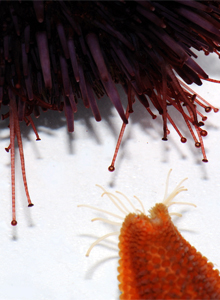-
May 19, 2014
The Mysterious Disappearing Cuttlefish -
May 19, 2014
The Evolution of Complexity -
May 19, 2014
A Tale of Two Sea Urchins -
May 19, 2014
If You Don't Have It- Steal It: Sea Slug Defenses -
February 18, 2014
Moving On Rainbow-Colored Legs: Cilia And Cteno... -
November 21, 2013
Ancient History: Tyrian Purple -
October 09, 2013
The Central Limit Theorum -
October 08, 2013
Sexual Dimorphism: The Spoonworm -
October 08, 2013
When Your Trash is Another's Treasure: Sustaini... -
September 04, 2013
Untangling DNA -
June 09, 2013
PhyloTree -
April 18, 2013
6 Tips for Achieving Invisibility -
February 28, 2013
Apolemia -
February 28, 2013
Chestnut Blight -
February 28, 2013
Nautilus -
February 28, 2013
Mud Skipper -
February 28, 2013
Glaucus atlanticus -
October 18, 2012
The Vertebrate Vascular System -
October 11, 2012
3D Printed Nematocyst -
September 20, 2012
Narcomedusae -
September 12, 2012
Doliolids -
September 12, 2012
How to Hide -
September 12, 2012
Ocean Slime -
July 05, 2012
Zoostalgia -
March 16, 2012
Echinoderm Skin -
March 16, 2012
Rhizocephala -
March 16, 2012
Jumping Spider -
March 16, 2012
Lifecycles, by Manvir Singh -
March 16, 2012
Anglerfish -
March 16, 2012
Tardigrades -
March 16, 2012
Resurrection Fern -
September 14, 2011
Passing Cloud -
June 02, 2011
Gelatinous Animals -
May 23, 2011
Hollow Trees -
May 23, 2011
Postdoc Position Available in the Dunn Lab -
May 11, 2011
Life on a Lobster Mouth -
May 04, 2011
Exciting Announcement -
March 08, 2011
Antartic Krill Love Dance -
January 28, 2011
Gyrodactylids -
January 18, 2011
Chasing Ghosts in Aotearoa -
January 10, 2011
Tangled String -
January 06, 2011
Waiting for the Bus -
January 04, 2011
Practical Computing for Biologists -
December 14, 2010
The Stomatopod Strike -
December 03, 2010
Moray Eel -
November 01, 2010
Gone Fishing -
October 26, 2010
Perspective of a Bird -
October 07, 2010
Know Your New England Bioluminescants -
October 01, 2010
Jellyfish Capsule Hotel -
September 20, 2010
Siphonophore Snacks -
September 08, 2010
What is a Cell? -
August 12, 2010
Corals and Coloniality -
July 20, 2010
Jellyfish Theater -
July 16, 2010
Axolotls and the French Intervention -
July 07, 2010
More Budding Jelly Babies -
June 24, 2010
Salty Pups -
June 17, 2010
Centerless Self -
June 08, 2010
How Do Krill Grow? -
May 26, 2010
Bone Boring Worms -
May 17, 2010
A Tale of Two Nuclei -
May 07, 2010
Be Still Its Beating Heart -
April 30, 2010
CreatureCast – Sea Stars -
April 22, 2010
Seeing the Invisible -
April 09, 2010
CreatureCast – Individuality -
March 30, 2010
Hitching a Ride -
March 18, 2010
Tube Vision -
March 08, 2010
CreatureCast – Diving for Jellies -
February 18, 2010
After the Fall -
February 10, 2010
Solar Powered Sea Slugs -
January 27, 2010
CreatureCast – Picky Females -
January 20, 2010
Spicules and droplets -
January 14, 2010
CreatureCast – Pattern Shifting Snails -
January 11, 2010
CreatureCast – Comb Jellies -
January 07, 2010
Stack of plates in action -
December 29, 2009
Making babies like a stack of plates -
December 23, 2009
CreatureCast – Marine Worms -
December 22, 2009
Pelagic plastic -
December 18, 2009
CreatureCast Episode 3 -
December 17, 2009
Thou shalt covet thy neighbor’s cnidocytes -
December 16, 2009
The art of knotting -
December 09, 2009
Star colonies of sea squirts -
December 08, 2009
Postdoc position in the Dunn Lab -
December 02, 2009
Mating when you are stuck to a rock -
November 20, 2009
Deadly bands -
November 12, 2009
Mitochondrial lenses -
November 09, 2009
Marnix Everaert -
November 06, 2009
A tale of two holes -
October 30, 2009
Fall in Rhode Island -
October 28, 2009
Glowing worms in the deep sea -
October 26, 2009
Hiding submarines beneath jellyfish -
October 22, 2009
Retractable spots -
October 20, 2009
Evolution by co-option
« Prev « Prev Next » Next »




 As a student of science, I love how even something close to home can
take me completely by surprise. I study sea urchin development, and yet
until recently I had no idea that urchins can see. I find this
fascinating because they do not have eyes, at least not as I typically
think of them. I first learned of this at a talk about feet, of all
things. Feet may be the organs by which urchins largely experience
their world. Sea urchins have hundreds of feet: thin, muscular tubes
with suction cups at the ends. In the video below, you can see how
their combined action allows the animal to move (slowly). The role of
the tube foot goes beyond locomotion, however.
As a student of science, I love how even something close to home can
take me completely by surprise. I study sea urchin development, and yet
until recently I had no idea that urchins can see. I find this
fascinating because they do not have eyes, at least not as I typically
think of them. I first learned of this at a talk about feet, of all
things. Feet may be the organs by which urchins largely experience
their world. Sea urchins have hundreds of feet: thin, muscular tubes
with suction cups at the ends. In the video below, you can see how
their combined action allows the animal to move (slowly). The role of
the tube foot goes beyond locomotion, however. In these experiments, urchins would react to the presence of dark targets that looked like nice holes to crawl into in their tank. But they only recognized them if they were above a certain size, implying that their visual perception has a resolution of that certain size, and that they're not just recognizing simple light or dark cues.
In these experiments, urchins would react to the presence of dark targets that looked like nice holes to crawl into in their tank. But they only recognized them if they were above a certain size, implying that their visual perception has a resolution of that certain size, and that they're not just recognizing simple light or dark cues.  in front of each receptor. Where does sea urchins' resolution come from? It's possible that their spines block out all light except that which is directly in front of any given photoreceptor. When combined, all of the photoreceptors across the whole sea urchin body (each one only seeing what's in front of it) may function as a giant compound eye like that of an insect. And if fact, it turns out that the resolution of sea urchin vision actually correlates well with the spacing between their spines. The resolution is modest, but enough to allow for some complex behavior, helping them seek shelter, locate food, or flee from predators. Sea urchins lack a central nervous system or anything resembling a brain, so I find it amazing that they are able to process images.
in front of each receptor. Where does sea urchins' resolution come from? It's possible that their spines block out all light except that which is directly in front of any given photoreceptor. When combined, all of the photoreceptors across the whole sea urchin body (each one only seeing what's in front of it) may function as a giant compound eye like that of an insect. And if fact, it turns out that the resolution of sea urchin vision actually correlates well with the spacing between their spines. The resolution is modest, but enough to allow for some complex behavior, helping them seek shelter, locate food, or flee from predators. Sea urchins lack a central nervous system or anything resembling a brain, so I find it amazing that they are able to process images.


















Ps. I love this blog! keep doing this great job!